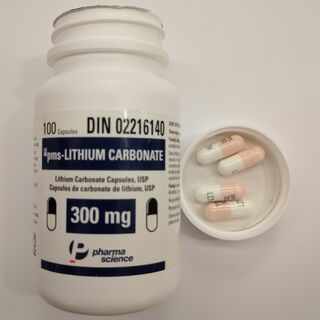Bipolar Disorder
A Return to Lithium: Psychiatry's First Miracle Drug
One of psychiatry's oldest drugs, lithium may be making a comeback.
Posted July 6, 2020 Reviewed by Lybi Ma
Lithium has long been described as the "penicillin of psychiatry" and the "gold standard" in the treatment of bipolar disorder, yet its use in the United States has decreased steadily in the past 25 years. A quick literature search for lithium therapy reveals a multitude of recent articles on its superior efficacy in the treatment of mood disorder—and its underutilization in favor of other, newer agents (see, for example, Rybakowski, 2018).

Now, a new paper published in the Australian and New Zealand Journal of Psychiatry concludes that "in practice, lithium should be prescribed to all [emphasis added] patients with bipolar disorder, unless there is a specific reason why an alternative is preferable or is better suited" (Malhi et al., 2020).
Lithium's history stems from the Roman Empire when physicians would send nervous and temperamental patients to bathe in particular bath springs in southern and eastern Europe. We now know that these particular bath springs contain the highest natural concentration of lithium salts anywhere in Europe (see Fieve, 1975, for an excellent description). The drug was (re)discovered in modern times by the Australian psychiatrist John Cade in 1948. With Cade's pioneering work, lithium ushered in a new era in psychiatry: the psychopharmacological revolution. Its discovery predates the discoveries of the first antipsychotic and antidepressant agents, which would come a few years later.
Still, lithium was not approved by the U.S. Food and Drug Administration until 1970—22 years after its discovery by Cade—chiefly because there was no pharmaceutical company incentive to invest in the drug. As a naturally occurring salt (listed on the periodic table of the elements), lithium could never be patented, and it would never be a money-maker for the drug companies.
Something of a "lithium underground" developed in the U.S., as psychiatrists began prescribing the drug in the 1960s without FDA approval. Ronald Fieve, who would go on to become a champion for lithium and the originator of the bipolar II disorder concept, helped establish the first lithium clinic in the U.S. at Columbia University in 1966.
Psychiatrists trained in the 1970s and 1980s became well acquainted with lithium's administration, and lithium clinics proliferated around the country during this time. By the late 1990s, however, lithium's popularity began to decline, with one well-known psychiatric historian noting that residents trained during and after this period became generally "untutored in lithium use, and … uncomfortable in using it in practice" (Shorter, 2009, p. 6). Anecdotally, I have seen one patient with bipolar disorder tried on 12 different psychotropics before being offered a trial of lithium, which finally stabilized the patient's increasingly severe mood swings.
Lithium's underutilization appears to be a uniquely American problem, as its use in some European countries remains high (Post, 2017), an indicator that its underuse may be more related to healthcare system issues than the discovery of a safer or more effective alternative.
A frequent concern raised about lithium therapy is the risk of side effects, including lithium toxicity, which occurs when lithium is dosed too high or is taken in overdose. However, as Rybakowski (2018) notes, lithium's side effects are often overestimated by prescribers, and the drug's long-term safety at appropriate doses has been well-established. Years of anti-lithium advertising by the pharmaceutical companies has contributed to these negative perceptions surrounding lithium treatment.
Fortunately, there now appears to be broad consensus in academic psychiatry that lithium, long-recognized as the single most effective mood-stabilizing agent, is underused—and that this represents a major problem in bipolar disorder treatment. Psychiatry's "orphan drug," long unsupported by any major pharmaceutical company, may be making a comeback.
References
Fieve, R. R. (1975). Moodswing: The third revolution in psychiatry. Morrow.
Malhi, G. S., Bell, E., Porter, R. J., Boyce, P., Mulder, R., Hopwood, M., … Berk, M. (2020). Lithium should be borne in mind: Five key reasons. Australian & New Zealand Journal of Psychiatry, 54(7), 659–663. https://doi.org/10.1177/0004867420934189
Post, R. M. (2017). The new news about lithium: An underutilized treatment in the United States. Neuropsychopharmacology, 43, 1174-1179. https://doi.org/10.1038/npp.2017.238
Rybakowski, J. K. (2018). Challenging the negative perception of lithium and optimizing its long-term administration. Frontiers in Molecular Neuroscience. https://doi.org/10.3389/fnmol.2018.00349
Shorter, E. (2009). The history of lithium therapy. Bipolar Disorders, 11(02), 4-9. doi:10.1111/j.1399-5618.2009.00706.x


